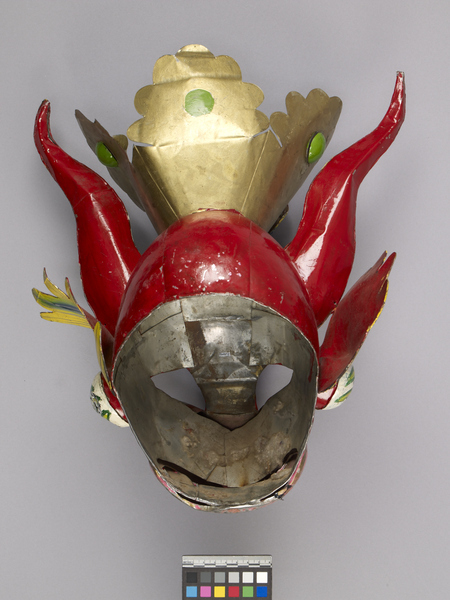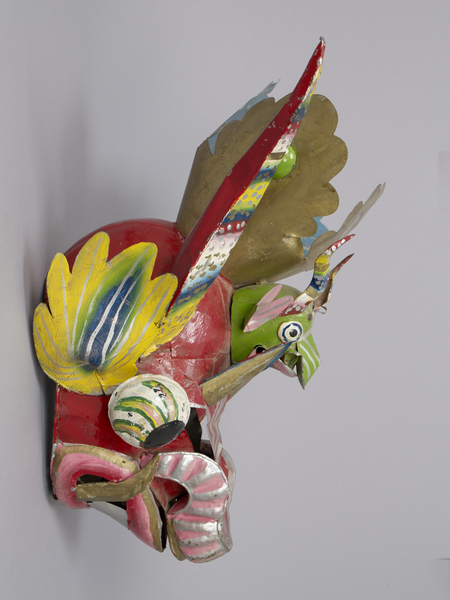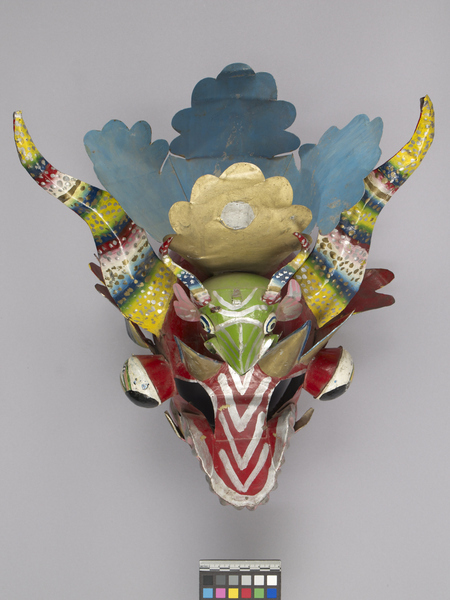Devil King Mask Item Number: 2946/12 from the MOA: University of British Columbia




Description
Devil king mask with a red face, golden crown, short twisting horns and a dragon at the top. The eyes bulge out on either side of the face and are decorated with large black pupils and pink and green striped lashes. The red bridge of the nose is decorated with silver chevrons. The mouth forms a snarl with its three silver teeth framed on either side by large golden fangs. There are three blue-trimmed golden horns on the forehead. The rubbery ears are shaped like flames and fade from dark blue near the centre to yellow at the edges. The horns have short, multi-coloured stripes decorated with silver and gold dots. The small green, dragon-like creature has golden teeth and fangs, pink ears, and geometric silver designs across the forehead and nose. The crown has green, half-sphere shaped projections on both sides. The inside of the crown is light blue and light pink.
History Of Use
Supay mask; used in the diablada dance performances, during the Virgin of Candelaria feast days. For the people of the Andes, metals were considered "like the harvests, products of the earth", and to extract them, in the colonial period and today, a prospective miner or speculator must be prepared to make a contract with their proprietor. There were various proprietors throughout the centuries, with Supay, also identified as Apo Parato, appearing around 1650. Miners made offerings of chicha, feathers, and diminutive wax effigies for Supay; they hoped for clothes, silver, and food in return. In many of his depictions, Supay has a large erect phallus and can return a miner's lost virility. He has an intimidating and belittling attitude to his supplicants, and the minerals hidden in his cavernous world are often though to be false riches. He is associated with the remaking of the world after the Spanish invasion; also associated with sickness and death.
Item History
- Made in Puno, Puno, Peru during 1985
- Collected by Anthony A. Shelton during February 2012
- Owned by Anthony A. Shelton before March 12, 2012
- Received from Anthony A. Shelton (Seller) and Museum of Anthropology Exhibitions Budget (Funding source) on March 12, 2012
What
Who
- Culture
- Peruvian
- Field Collector
- Anthony A. Shelton
- Previous Owner
- Anthony A. Shelton
- Received from
- Anthony A. Shelton (Seller) and Museum of Anthropology Exhibitions Budget (Funding source)
Where
- Holding Institution
- MOA: University of British Columbia
- Made in
- Puno, Puno, Peru
When
- Creation Date
- during 1985
- Collection Date
- during February 2012
- Ownership Date
- before March 12, 2012
- Acquisition Date
- on March 12, 2012
Other
- Item Classes
- metalwork
- Condition
- fair
- Accession Number
- 2946/0012